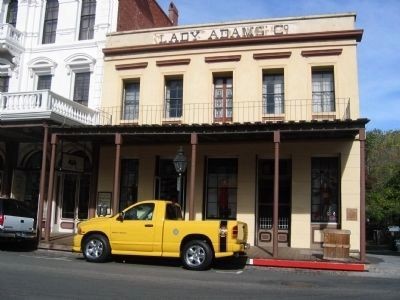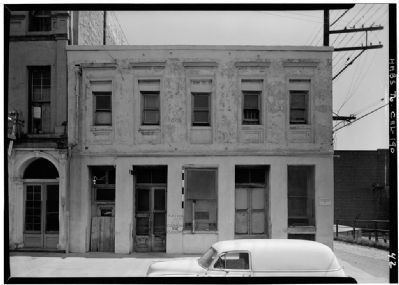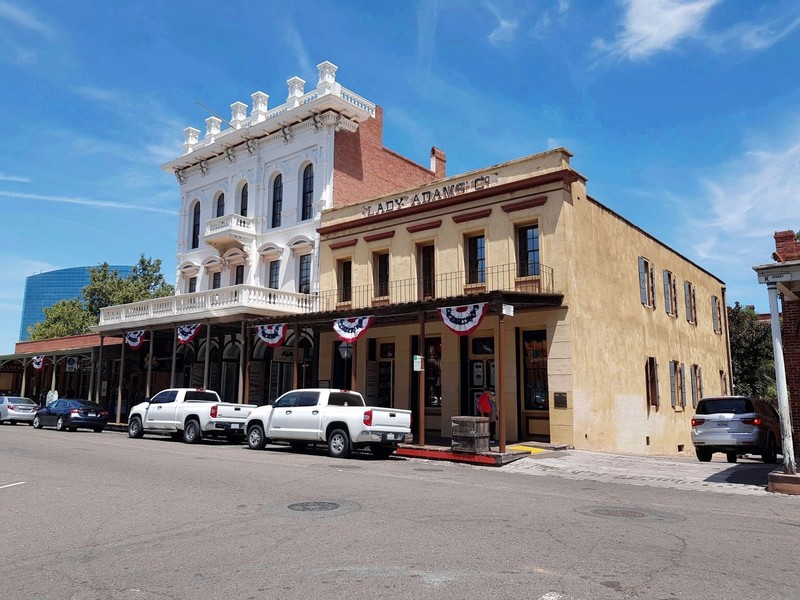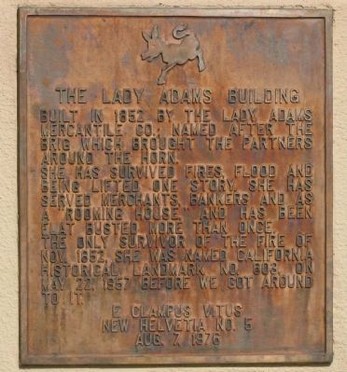The Lady Adams Building
Introduction
Text-to-speech Audio
Sacramento is home to one of the oldest and most resilient buildings in the area: The Lady Adams. This building was the sole survivor of a massive fire in Sacramento and years later it once again stood strong amidst a destructive flood that affected the greater Sacramento area. The refurbished Lady Adams now lives on as a kitschy tourist shop in the middle of Old Town Sacramento.
Images
The front of the Lady Adams, November 14, 2005

The front of the Lady Adams, circa July 1965

The Lady Adams, November 14, 2005

The plaque outside the Lady Adams, November 14, 2005

Backstory and Context
Text-to-speech Audio
The Lady Adams building was built in Sacramento, California in June of 1852, by four German immigrants. Immigration at the time, particularly German immigration, was very prominent. “German states brought a wave of highly idealistic new immigrants to America, and the number of Germans entering the U.S. surged after 1850” (Carlson, “The Peculiar Legacy of German-Americans”). These idealistic immigrants pursued unique business opportunities as well as farming which allowed them to “Americanize” themselves successfully. “Most historians concur that by 1900 most German Americans were rapidly assimilating into American society” (Carlson, “The Peculiar Legacy of German-Americans”). The four German immigrants on the Lady Adams decided to open up a floating mercantile shop on the Sacramento River, naming their store after the ship that had brought them to California three years before. This ship actually was repurposed during the building of the store as many parts were used in the building process, such as bricks which were formerly the ship’s ballast. In total, the entire building cost $29,000, which is about $1.06 million today (Trevor “The History of Old Sac's Oldest Building”). One of the most significant parts of the building was its heavy brick roofing, as that is what allowed the building to survive future natural disasters.
The Lady Adams building is particularly significant because of the numerous natural disasters that it has survived over the 171 years that it has been standing. In 1852, Sacramento suffered a huge fire that burned 761 buildings in town. The only building that survived was the Lady Adams herself thanks to the aforementioned solid brick roofing (Trevor “The History of Old Sac's Oldest Building”). Just 10 years later Sacramento faced yet another disaster, this time a flood which occurred when the levees in the Sacramento area broke causing the city to be consumed with water (“California’s Super Flood”). Despite most other buildings dealing with significant damage, the Lady Adams once again stood strong and later was raised one level as a precaution for any possible future flooding (“Lady Adams Building Historical Marker”). Eventually in the 1970s, the reliable heavy brick roof did collapse, but it was proudly rebuilt and restored. Old Sacramento, the block of Sacramento where the building resides, has preserved the memory of this building and has maintained its original design rather than acclimate it to modern architectural choices.
The Lady Adams has served various different purposes throughout the years. It began originally as a mercantile store, but it sadly went bankrupt and was sold to the law firm Fogus and Coghill where they operated business until 1868. After sitting abandoned for about 80 years, the once seemingly “family friendly” environment of the Lady Adams was entirely abandoned as in the 1950s it became a less than respectable brothel and a flophouse, but it then once again was left vacant. Knowing the significant history of the building, the city of Sacramento took a while to decide what to do with the building. Eventually, it was declared California Historical Landmark No. 603 in 1957 and with this new title, Sacramento worked to refurbish the building in the 70s and restore the structure so that it could be used by its new occupants Evangeline’s. In 1976, E Clampus Vitus, “a fraternal organization dedicated to the study and preservation of Western Heritage, in particular the history of the Mother Lode and gold mining regions of the area,” erected a plaque for the Lady Adams as a lot of their work was recognizing “those sites such as bordellos and saloons overlooked by more traditional historical societies” (“Guide to the E Clampus Vitus Historic Sites Collection MS 49”). The plaque (image featured below) outlines the history of the building and mentions its recent declaration as a California Historical Landmark, which is provides a bit more details compared to the actual California Historical Landmark description which states that “This store and office building was erected in 1852 from materials brought around the Horn in the ship Lady Adams” (“Sacramento”). Now the Lady Adams is a cute gift shop filled with unique trinkets and art pieces that both tourists and locals enjoy visiting.
Sources
California State Parks, State of California. “Sacramento.” CA State Parks, https://ohp.parks.ca.gov/?page_id=21454.
“California's Super Flood.” EarthDate, 2020, https://www.earthdate.org/episodes/californias-super-flood.
Carlson, Allan C. “The Peculiar Legacy of German-Americans.” Society, vol. 40, no. 2, Jan. 2003, pp. 77–88. EBSCOhost, https://doi.org/10.1007/s12115-003-1055-3.
“Guide to the E Clampus Vitus Historic Sites Collection MS 49.” Online Archive of California, https://oac.cdlib.org/findaid/ark:/13030/c8zp4bwd/entire_text/.
“Lady Adams Building Historical Marker.” Historical Marker, 7 Feb. 2023, https://www.hmdb.org/m.asp?m=58582.
Peters, Trevor. “The History of Old Sac's Oldest Building.” SACtoday, SACtoday, 22 Mar. 2022, https://sactoday.6amcity.com/oldest-building-lady-adams-sacramento-ca.
“This Day in History: Sacramento History Museum.” Sacramento History Museum |, 23 Jan. 2020, http://sachistorymuseum.org/field-trips/fun-facts/.
Photographed By Syd Whittle
Photographed By Glen Fishback, Photographer
Photographed By Syd Whittle
Photographed By Syd Whittle
